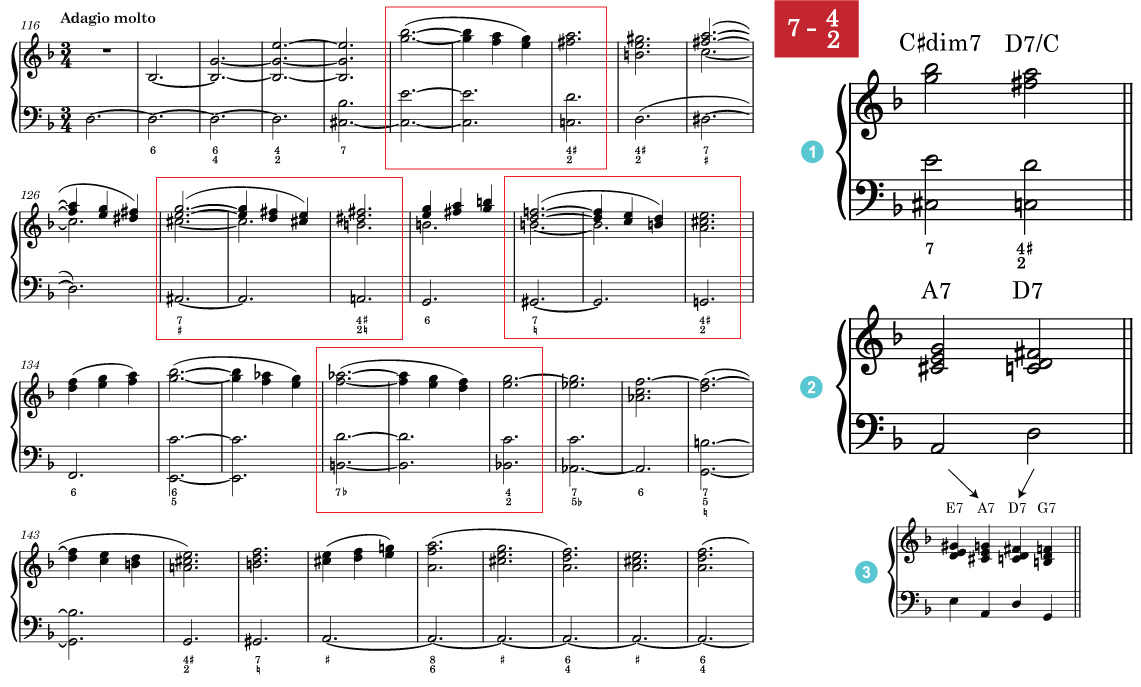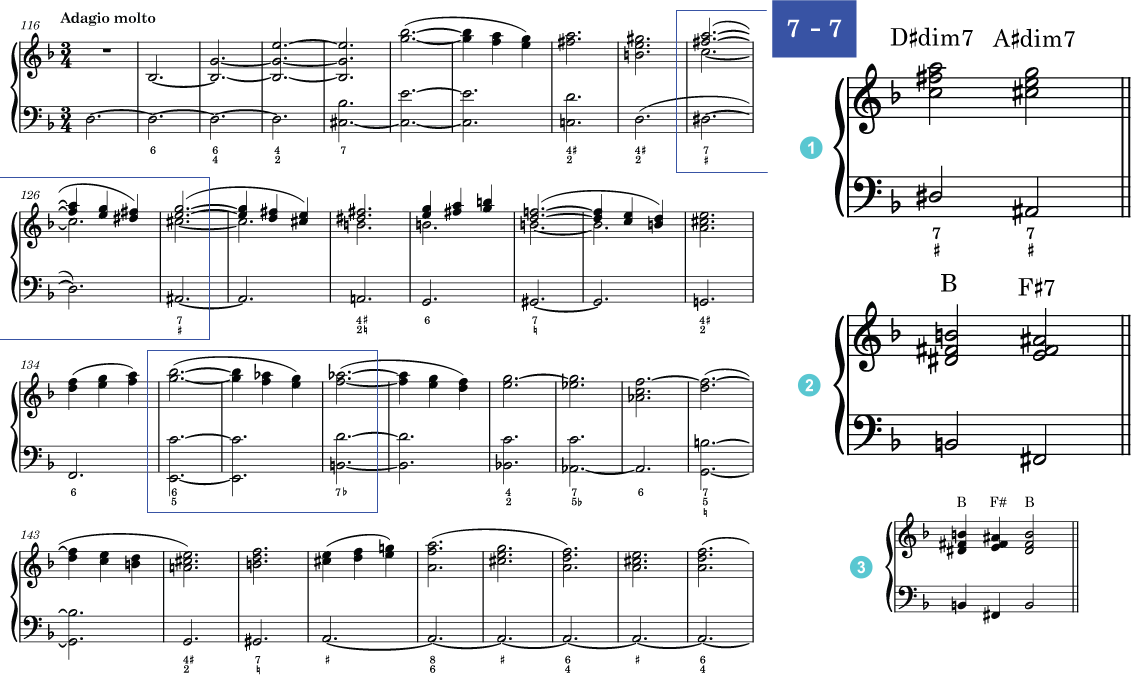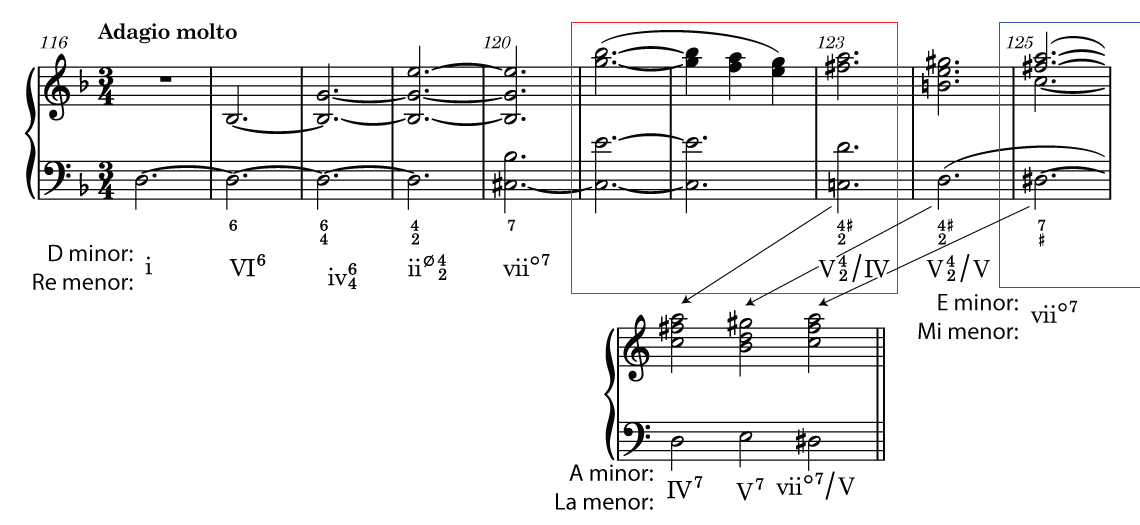Vivaldi - L'Autunno (Autumn) - II Adagio molto
José Rodríguez Alvira
Everyone is made to forget their cares and to sing and dance
By the air which is tempered with pleasure
And (by) the season that invites so many, many
Out of their sweetest slumber to fine enjoyment.
The second movement is an Adagio molto. The chromaticism is surprising. It makes us think of later examples, such as Wagner's famous Prelude to Tristan and Isolde.
We will begin by discussing two patterns that recur in the adagio. We will call the first one 7 - 42 or red pattern. We first encounter it in measure 131:
- It is a diminished seventh chord, in this case, D minor's vii degree chord, which instead of resolving to tonic, resolves unexpectedly to a dominant chord in third inversion (see number 1 on the right of the image).
- If we substitute the vii degree of D minor for its dominant (both chords share the dominant function) and change the second chord to root position, we find a dominant resolving to its tonic.
- In number 3 we see that these chords are part of a cycle of fifths.
This pattern is repeated three times (marked with red boxes):

We find a second pattern that we will call pattern 7 - 7 or blue pattern.
- A diminished seventh chord moves by descending fourth or ascending fifth to another diminished seventh chord.
- We replace the diminished seventh chords with their related dominants (D# dim -> B and A#dim -> F#).
- In number 3, we see that it is nothing more than a dominant alternating with its dominant.
This pattern is repeated only once (marked with blue boxes). When repeated, the first chord is a dominant instead of vii degree (V dominant of F, instead of E, vii of F):

With these patterns clarified, we can analyze the movement.
Measures 116 - 125
- We begin with a D pedal over which different chords of the key of D minor are presented until we reach the vii degree (measure 120).
- Vivaldi indicates that the basso continuo should arpeggiate the chords. However, the addition of notes on the stringed instruments creates mystery and uncertainty even though they are chords of the key.
- D minor's vii degree resolves as we discussed earlier, to a D dominant seventh (123).
- The D dominant seventh moves to an E dominant (also in third inversion, measure 124) followed by a diminished seventh. If we move these chords to A minor, we see that it is a simple IV7-V7-viio7/V movement, where the IV is a dominant seventh because of the use of the melodic minor scale. We have put the chords in root position for clarity.

John Harrison, violín, Robert Turizziani, director. Wichita State University Chamber Players.
Creative Commons Attribution-ShareAlike 4.0
Measures 126 - 133
- The diminished chord in measure 125 resolves using the blue pattern described above.
- From measures 127 to 129, Vivaldi reproduces the red pattern.
- In measure 130, we see for the first time a dominant resolving to its tonic (albeit in first inversion).
- The red pattern is repeated in measures 131 to 133 (key of D minor).

John Harrison, violín, Robert Turizziani, director. Wichita State University Chamber Players.
Creative Commons Attribution-ShareAlike 4.0
Measures 134 - 142
- In measure 134 we see for the second time a dominant resolving to its tonic (D minor).
- The blue and red patterns are chained in measures 135 to 139 in the key of F minor.

John Harrison, violín, Robert Turizziani, director. Wichita State University Chamber Players.
Creative Commons Attribution-ShareAlike 4.0
Measures 143 to the end
- The IV7-V7 in measures 143 and 144 brings us back to D minor.
- The movement ends with a dominant pedal.


John Harrison, violín, Robert Turizziani, director. Wichita State University Chamber Players.
Creative Commons Attribution-ShareAlike 4.0
Complete Movement
John Harrison, violín, Robert Turizziani, director. Wichita State University Chamber Players.
Creative Commons Attribution-ShareAlike 4.0

This work is licensed under a Creative Commons Attribution-NonCommercial-NoDerivatives 4.0 International License. José Rodríguez Alvira.
Published by teoria.com